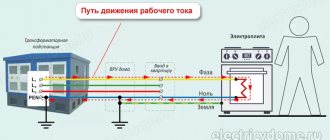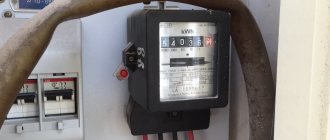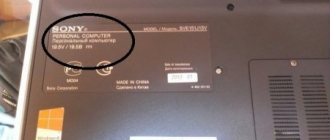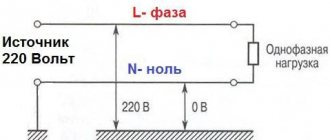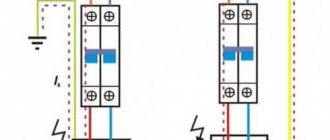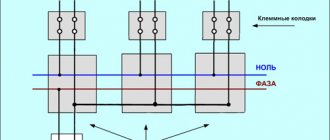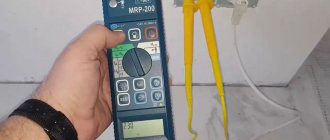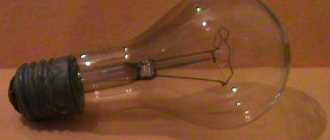What happens if you confuse zero with ground?
For electrical appliances plugged into an outlet, the type of connection does not matter - LN or L-PE. In any case, there will be a standard voltage at the terminals of the device. However, when connecting the grounding of the outlet to zero, a number of negative consequences are possible:
- Incorrect operation of the RCD. The operating principle of these protective devices is to constantly compare the currents flowing through the neutral and phase conductors. When connecting the ground instead of the neutral or connecting these terminals to each other in the socket and turning on any electrical appliance, a leakage current appears, which will lead to the protection being activated and the line being disconnected.
- There is a danger of electric shock. If the grounding conductor, connected instead of the neutral one, breaks in the area between the socket and the grounding loop, it will be connected to the phase wire through the electrical appliance. As a result, mains voltage will appear on the housings of other grounded devices.
- Destruction of the ground loop. When the grounding wire is connected not to the supply transformer, but to a separate grounding loop, electric current begins to constantly flow through it. This leads to the rapid release of parts of the circuit located in the ground due to electrocorrosion.
HOW TO DETERMINE PHASE, ZERO and GROUNDING OF WIRES YOURSELF
So, let's start in order:
PHASE DETERMINATION
For greater convenience, it is always better to first determine which of the existing wires is phase. We have already written about how to find the phase with a digital multimeter, but what to do if you don’t have one, read below.
PHASE DETERMINATION WITH AN INDICATOR SCREWDRIVER
The easiest way to detect a phase wire is to search with an indicator screwdriver. Any home craftsman who does electrical work in an apartment should have this simple tool - be it full electrical installation, simple replacement of lamps or installation of lamps, sockets and switches.
The operating principle of an indicator screwdriver is simple - when the tip of the screwdriver touches a live conductor and at the same time touches the contact on the back of the screwdriver with your finger, the indicator lamp in the tool body lights up, which signals the presence of voltage. This way you can easily find out which wire is phase.
The principle of operation of the indicator screwdriver is simple - inside the indicator screwdriver there is a lamp and a resistance (resistor), when the circuit is closed (we touch the rear contact) the lamp lights up. Resistance protects us from electric shock; it reduces the current to a minimum, safe level.
DETERMINATION OF PHASE, ZERO AND GROUNDING BY CONTROL LAMP
Another way in which you can determine the phase, neutral and ground wires in a modern three-wire electrical network is by using a test lamp. The method is ambiguous, but effective, requiring special care.
How to distinguish between working zero and protective grounding
Due to the negative consequences of incorrectly connecting the neutral and grounding conductors during installation and repair work, it becomes necessary to distinguish one wire from another.
Unlike a phase conductor, measuring voltage with an indicator screwdriver will not help, so it is necessary to use other, more complex methods.
Disconnecting the ground wire in the shield
This is the simplest and most reliable method, for which it is enough to have a voltmeter or voltage indicator with two probes:
- 1. turn off the power to the line using the input circuit breaker;
- 2. disconnect the grounding wires in the electrical panel;
- 3. ensure the possibility of safe measurements at the second end of the cable;
- 4. apply power by turning on the input circuit breaker;
- 5. Measure the voltage between all three ends of the cable in pairs.
Between the neutral and phase wires, the indicator will show the presence of mains voltage. The remaining wire is ground.
Using differential protection devices
If there is an RCD or a circuit breaker in the circuit, you can check the correct installation using these devices. Incorrect connection of wires in the socket or connection of zero and ground will lead to immediate operation of the protection:
- 1. check the serviceability of the difrel by pressing the “TEST” button;
- 2. turn off the RCD;
- 3. plug in an electrical appliance or portable lamp;
- 4. turn on the RCD.
When the protection is triggered, change the wire connection and recheck the operation of the circuit.
| Important! The setting current of differential relays installed in apartment electrical panels is 30 mA, so the power of the electrical appliance or lamp must be more than 10 W. Otherwise, the leakage current will not be enough to turn off the protection. |
Protective grounding
This is the connection of metal parts to the neutral wire. In the event of a short circuit between the energized elements and the grounded housing, the circuit breaker trips and the power is turned off. The disadvantage of protective grounding is that in this case the differential protection does not operate.
In addition, if the neutral wire breaks, the body of the electrical appliance becomes energized. This situation also occurs in the case of a stuck phase contact in a circuit breaker.
Grounding
This is the connection of the equipment body with a separately laid conductor and specially manufactured metal structures located in the ground. Such a system is more reliable and in the event of a circuit break does not lead to high voltage.
Therefore, according to PUE clause 7.1.36 and GOST 12.1.030-81 SSBT, installation of grounding is a mandatory protective measure. These documents provide a clear answer to the question: can the grounding be reset to zero? Doing this is strictly PROHIBITED.
It is allowed to connect these conductors only when connecting the building to the TN-CS system in the electrical panel BEFORE the input circuit breaker , and it is not allowed to press these wires with one clamp.
Dangerous defense option
Some would-be electricians decide to ground the apartment by simply connecting the third wire to the plumbing or heating system running through the room. Do not use this type of ground loop under any circumstances, because... in this case the picture is as follows:
a breakdown of current occurs on the body of an electrical appliance (boiler or washing machine in the bathroom); dangerous current passes to batteries and hot/cold water risers not only of your apartment, but also of all neighbors, because the system is unified. Anyone who at the moment decides to drink water from the tap or simply touch metal pipes can become a victim.
By the way, the rules of the PUE stipulate this point and are also strictly prohibited, according to PUE 1.7.110.
In addition to this method of grounding an apartment, the following are also considered unsafe:
Connection in the socket of a neutral with a grounding conductor (the so-called grounding). If the neutral wire in the network suddenly breaks, dangerous voltage will transfer to the housing of all electrical appliances connected to the grounding of the apartment - computer, water heater, refrigerator, etc. Sequential grounding of electrical appliances (through each other). If you decide to make such a grounding loop, be aware that if an accident occurs, electromagnetic incompatibility may occur. As a result, electrical installations will create interference and there is a high likelihood that the ground loop will not prevent electric shock. Connecting several wires to one PE bus terminal. One conductor can be connected to each contact pad. Neglecting this rule is strictly prohibited.
We recommend: How to hide TV wires on the wall: a selection of ideas in the photo
Consideration of the issue by a specialist
That's all you need to know about how to make grounding in an apartment if there is none. We still strongly recommend using an RCD as a temporary protection option, and insist that the city authorities take care of upgrading the electrical wiring in your home.
Related materials:
There is an electric current in the bathroom - what to do How to connect a voltage control relay Proper grounding in a private house
Features of the TN-CS power supply system
Residential areas are powered using step-down transformers with a solidly grounded neutral. This means that the secondary windings are connected in a star configuration, the middle point of which is connected to the ground loop without breaks or switches.
Modern safety measures provide for a five-wire TN-S power supply circuit - 3 phase wires, neutral and ground. The last two conductors are connected to the neutral of the supply transformer.
The transfer of all residential buildings to this power supply scheme involves replacing the previously used four-wire TN-C system and will be quite expensive. Therefore, a compromise option was developed - the TN-CS grounding system.
Its description and technical requirements are specified in the PUE pp. 1.7.3, 1.7.131-135 and Fig. 1.7.3. The main feature of this power supply option is the use of a combined PEN conductor in the section from the supply transformer to the entrance to the building, where it is divided into two wires - neutral N and grounding PE. At the separation point, according to PUE clause 1.7.61, these wires must be connected to the building’s grounding loop.
Content
Grounding for a new building How to ground in an old house? Reasons that exclude the installation of grounding Video about grounding and grounding in detail
Before starting work, you need to find out which system is used in your home. According to the rules that were adopted back in 2003, each building must be equipped with a riser of five wires, in which the 5th wire is precisely the grounding conductor. If everything is exactly like this in your house, then all you have to do is distribute the grounding wire throughout the apartment (the third core in the cable), then install special sockets with grounding everywhere, and arrange a DSUP in the bathroom.
1. So, in new (post-Soviet) houses, this is, as a rule, a modern TN-C-S system (it has zero both working and protective conductors, which are usually connected in the main panel of the building; then they are disconnected everywhere). In this system, 3 phases L, as well as a separated N (working neutral) and PE (protective conductor) are suitable for the access risers. The connection process is much simpler, since the floor panel already has separate buses designed for connecting zero, phase and grounding. And the grounding bus has a metal connection with the electrical panel housing.
Apartment power supply TN-CS
It is not difficult to determine whether your home is connected by (TN – C – S). Just look at the cable that goes to the riser (input). It should have 5 wires:
3 phases such as L1, L2, L3; protective zero PE; working zero N.
The connection is made as follows:
the phase wire from the apartment is connected to the same bus where the previous old wire was; the working neutral N wire is connected to the bus with neutral wires; The PE grounding wire (neutral protective) is connected to the panel body.
Important! You cannot connect all the grounding wires (which are in the panel) to 1 bolt (clamp)! It is necessary to use different bolted connections. It is better to use a busbar: screw it to the shield, then connect the PE.
An example of separation by household appliances: lighting devices, power supplies, large household appliances are grounded separately
It is also important to consider the following:
with a 3-phase input, absolutely all conductors must have the same cross-section (for copper up to 16 mm2); under 1 terminal of the machine you can clamp up to 2 conductors of the 1st section; to obtain a uniform load, a 3-phase connection to the hob would be preferable; all metal parts in the bathroom (pipes, heated floor screen, bathtub, etc.) and the grounding conductor of the socket (of course, if there is one in the bathroom) must be connected to the DSUP (or KUP) bus, which must be located there. In this case, the socket is powered using a 3-wire circuit; all PE conductors with mechanical protection should have a cross-section of 2.5 mm2, if not, 4 mm2. The conductor from the DSUP bus to the PE panel bus (preferably a floor one) should have a cross-section of 6 mm2; It is preferable to separate lighting and power (socket) circuits. However, mixed power supply is allowed. And the lines to all power units (stove, oven, CM) must be separate.
2. In some new type of apartment buildings (since 1997) TN-S is used throughout the entire length of the building. This grounding is the most reliable. When connecting a house, the grounding wire is laid separately, together with the phase and neutral wires from the substation to the electrical panels of the house. The work is carried out in the same way as in TN – C – S.
Visual representation of TN-S: output of each element, including the neutral cable, to a separate grounding bus
In old houses, a TN-C system is usually found, in which throughout its entire length the neutral conductors (working and protective) are combined into one neutral conductor (PEN). We connect the body of the electrical equipment (electrical device, panel body or assembly) to the PEN conductor. Such protection is called nullification. The grounding circuit is installed at the substation that supplies the house. 3 phases L, as well as a combined PEN conductor, are suitable for the access risers. All floor panels in such a system are grounded, and grounding is not provided for them.
We recommend: How to make a septic tank with your own hands for a private home?
TN-C grounding system
Electrical wiring in the case of single-phase power supply to the living space is carried out with 2-core cables (phase, PEN). Or 4-core cables (A, B, C, PEN) with 3-phase power supply to the apartment. There are no protective grounding contacts in the sockets.
This is the oldest and most common system. It existed in the USSR for a very long time and, unfortunately, still continues to exist in many homes. There is a serious risk of electric shock when used. Automatic switches (protective switching devices) installed with the TN-C system protect electricity. circuits (groups, lines) only from short circuit currents. But protection against electric shock is completely absent.
Important! If an electrician recommends electrical installation using TN-C, do not hesitate to refuse! It is completely unable to protect against electric shock! The operation of electrical appliances with such a system poses a potential threat to life! In addition, the PUE (clause 1.7.80) prohibits installing an RCD in this grounding system as the main protection.
According to new standards adopted in 2003, in all old houses the TN-C system must be converted to either a TN-CS or TN-S system by upgrading the power supply circuits (installation of a potential equalization system). However, poor financing does not yet allow this to be implemented in all houses. In most cases, energy supply organizations proceed as follows: at the entrance to an apartment building, they re-ground the neutral wire. Then divide the PEN conductor into 2 separate wires:
zero (N) working conductor; protective (PE) conductor.
Important! If you have a TN-C system, unfortunately, you can’t do anything on your own regarding grounding! You cannot build your own personal storage unit! Since it will be located outside the EMS of the house and can cause the appearance of stray currents. Therefore, you can only use the existing common house system.
In other words, you need to either completely re-equip the entire wiring of the house to new standards, or use electrical appliances with a body made of non-conductive material. It is also recommended to install an RCD on the circuits that power household appliances. This is especially important in the bathroom. An RCD is not capable of protecting against electric shock, but it will save you from fatal shock.
If the grounding is not connected to water pipes, batteries, fittings and other conductive parts of the apartment, then dangerous voltage will appear between the equipment connected to such wiring and these parts. But even if you connect and the grounding turns out to be good, then from these structures the equalizing current through the grounding will flow through the entire apartment. Such currents can be very large, so if the PEN (main ground electrode) is broken, there will be a fire hazard due to excess currents. But that is not all. If voltage occurs on the housing of electrical appliances, grounded by a battery or water pipe, all pipes and batteries will come under voltage, including those in neighboring apartments. As a result, the neighbor who decided to pour water from the tap could be electrocuted to death! The ban on the use of pipes is written in VPUE 1.7.110. It is also impossible to simulate the circuit through a connection in a Euro socket of a “zero working” with a “zero protective” conductor. This is extremely dangerous. There are frequent cases of burnout of the “zero working” conductor in the shield. And this leads to the fact that on the case of a computer, refrigerator, etc. 220 V is placed. The only exception is grounding “to zero”, which is done in houses specially equipped for electric stoves. However, this should be done only after carefully examining the neutral conductor for cross-section (at least 16 square meters for aluminum), as well as continuity (according to PUE 7, paragraph 1.7.131). This must be done by a qualified electrician.
Thus, we see that in some cases it is not easy to carry out the circuit in an apartment. If it is a TN – C – S or TN – S system, then you can ground it yourself (that is, run the wires around the apartment). If it is an outdated TN-C, then even an experienced electrician will not help in the case of a separate apartment. It needs to be changed throughout the house.
Why two buses if they are connected anyway?
The very name of the TN-CS grounding system indicates that the neutral N and ground PE are combined only on part of the line. In the building they must be separated into separate wires. This was done for a number of reasons:
- the PEN wire laid in the area from the transformer to the entrance to the building has a larger cross-section and is less likely to fail than electrical wiring laid inside the building;
- according to PUE clause 1.7.145, the grounding wire cannot be disconnected, while the neutral conductor must be disconnected when repairing wiring and equipment.
Where it is necessary to connect zero to ground
The Electrical Installation Rules in clause 1.7.132 prohibit the use of a combined PEN wire in single-phase networks, therefore it is necessary to divide it into PE and N conductors before converting a three-phase line into three single-phase ones. Since almost all household electrical appliances are powered from a single-phase network, this is the voltage supplied to the apartment.
In order not to violate the requirements of this document, the grounding connection to zero is made in the input panel in the building. In multi-storey buildings, the division of a three-phase network into single-phase ones is carried out in floor panels, however, connecting zero and grounding here is undesirable due to unreliable contact of the electrical panel with the building's grounding loop.
| Important! According to the PUE standards, breaking PE and PEN lines is not allowed, therefore, the separation of the PEN conductor must be carried out before the four-pole circuit breaker, which simultaneously disconnects the linear and neutral wires. |
How to determine phase, zero and grounding yourself, using improvised means?
Anyone doing electrical work at home or simply deciding to install a chandelier, sconce, or connect an outlet will definitely be faced with the question - how to determine the phase, neutral and grounding of the wires at the installation site?
In our articles and instructions, we often post connection diagrams, rules for installing and connecting electrical equipment to the network, as well as much more, where in order to correctly perform all operations you need to know where your phase wire is, where the neutral (working zero) is, and where the ground wire is (protective zero). For an experienced electrician, determining where the phase and zero are or finding the ground is usually not difficult, but what about the rest?
Let's try to figure out how at home, without having complex specialized measuring instruments and electronic devices, you can determine for yourself where the phase is, where the zero is, and where the ground is in the wiring.
Of all the known methods, the simplest determination of phase and zero, we have selected the most, in our opinion, accessible to implementation and at the same time safe. For this reason, in the article you will not see advice on how to find the phase using potatoes or calls for briefly touching the wires with various parts of the body.
Why are the working zero and ground connected?
The connection of the neutral and grounding conductors in the water shield with simultaneous connection to the grounding loop of the building is carried out to increase the electrical safety of the residents of the house without replacing the cables supplying the building and converting the power supply system to TN-CS.
If this operation is not performed and the combined PEN wire is connected to the grounding contacts of the sockets, then the power supply will be provided according to the TN-C scheme. In this case, instead of protective grounding, grounding will actually be used, even if this conductor is additionally grounded in the water shield.
Such a protection system does not provide the necessary safety for people due to possible breaks and poor contact in the connection point of the wires used in electrical wiring. In this case, the housings of electrical appliances will be connected to the phase wire .
Therefore, the answer to the question “whether to connect zero to ground” depends on the number of wires approaching the house. When powering a building using a four-wire circuit, this must be done in the water panel, but if there is a fifth wire in the line through which the house is connected to the substation ground loop, this is prohibited in accordance with the PUE clause 1.7.135.
DIY grounding devices: diagrams and examples
As an example, let’s take the successful experience of a grounding device, carried out on the basis of an officially certified project, tested and approved for operation.
For a grounding device it is necessary:
Machine and welding helmet. Two shovels (scoop and bayonet). Hammer or sledgehammer. Steel angles. Steel rod. Wires. Electrodes. Corrugated pipe. Terminal.
For example, let's take a private house.
We mark the points at a distance of 1.5 meters from each other, hammer in 3 steel corners. between which we hammer in electrodes at a distance of 1.5 meters - 3 steel, 3-meter corners. The corners are driven in vertically, recessed to 50%! g (MISSING) of the depth of the dug ditch (about 50 cm from ground level). The ditch is dug in the shape of a triangle.
The corners are welded to electrodes driven into the ground, all planes are properly welded with a welding machine. After this, it is necessary to measure the grounding resistance.
Note! The maximum permissible resistance level is 30 ohms.
After checking the resistance, we proceed to weld the metal rod to the corner of the ground loop. The rod is laid to the house. After this, it needs to be lifted under the pediment and connected to the shield.
Using bolts, we connect it to the panel body and distribute it among electrical appliances and sockets, and fill the excavated soil into the ditch.
Let's look at another example.
To set up this system you will need:
grounding stakes; metal jumpers for combining stakes; transmission lines from the circuit to the shield.
The diagram shows the most popular grounding model:
4
Grounding for a group of outlets
At the moment, manufacturers have already produced a large number of affordable European and American sockets. But in the CIS and Europe, the most common is the European type. They have a “phase”, “zero”, as well as a grounding contact that protrudes from the housing by 4-5 mm.
In fact, diverting electricity from outlets is a very important step, without which no existing premises can do. For strong and reliable protection of sockets, you will need a screwdriver, electrical tape, pliers and a special cable that must be connected to the grounding contact on the reverse side.
We recommend: Installing a well head with your own hands
European-type sockets have a grounding contact that protrudes from the body by 4-5 mm
It is the connection of the cable to the contact that makes the outlet grounded and absolutely safe for all residents. This is a very easy job that absolutely anyone can handle. You just need to study a few manuals or learn more from a specialist.
But it is strongly recommended to delegate the work to a specially trained person who can reliably and safely ground the outlets in your apartment. After all, manual intervention in the electrical system may not end entirely favorably.
